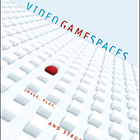Title: Video Game Spaces: Image, Play, and Structure in 3D Worlds
Author: Michael Nitsche
Publication Date: December 5, 2008
Publisher: The MIT Press
The move to 3D graphics represents a dramatic artistic and technical development in the history of video games that suggests an overall transformation of games as media. The experience of space has become a key element of how we understand games and how we play them. In Video Game Spaces, Michael Nitsche investigates what this shift means for video game design and analysis.
Navigable 3D spaces allow us to crawl, jump, fly, or even teleport through fictional worlds that come to life in our imagination. We encounter these spaces through a combination of perception and interaction. Drawing on concepts from literary studies, architecture, and cinema, Nitsche argues that game spaces can evoke narratives because the player is interpreting them in order to engage with them. Consequently, Nitsche approaches game spaces not as pure visual spectacles but as meaningful virtual locations. His argument investigates what structures are at work in these locations, proceeds to an in-depth analysis of the audiovisual presentation of game worlds, and ultimately explores how we use and comprehend their functionality.
Nitsche introduces five analytical layers—rule-based space, mediated space, fictional space, play space, and social space—and uses them in the analyses of games that range from early classics to recent titles. He revisits current topics in game research, including narrative, rules, and play, from this new perspective.
Video Game Spaces provides a range of necessary arguments and tools for media scholars, designers, and game researchers with an interest in 3D game worlds and the new challenges they pose.


